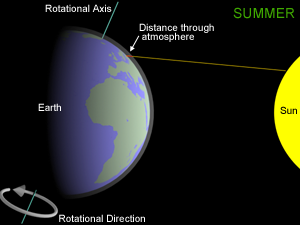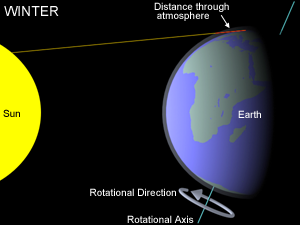|
| Earth & Moon | Our Solar System | Our Galaxy | The Universe | Historical Overview | Formulas | Links |
Earth, our home-planet.

|
This picture is an actual photo taken by one of many spacecrafts that have been launched by us, humans. This image
shows most of the African continent as well as large portions of the Antarctic (South Pole).
Earth is one of 9 major planets orbiting our Sun. It's a nice, little spherical body (Not a perfect sphere, though)
measuring some 12756 kilometers in diameter.
It has an average surface temperature of 22°C. It is conveniently located some 150 million kilometers from the Sun.
(Average distance) This results in an orbital period (around the Sun) of roughly 365 days. This is more commonly
known as 'one year'.
|
History
As far as we know, Earth is the birthplace of humanity. We still don't know if life started her on Earth or if it was
brought to Earth from outer space by comets or some other celestial body.
It is believed Earth is about as old as the rest of the Solar system, which of course makes sense, since the theory
states that the whole system (Sun, planets etc.) was created simultaneously with only minor local deviations. This age
is thought to be about 4.5 billion years.
Thousands of years ago when the first civilizations started to form, there basically was no science at all, at least
not as we know science today. We don't have very good records about how much people knew about Earth say about 10,000
years ago. However, we DO know much more about the ancient Egyptians, Babylonians, Sumerians and of course the ancient
Greeks. They all had made important contributions in terms of mathematics, observations etc.
Possibly one of the most impressive feats performed by ancient astronomers is the precise measurement of Earth's
circumference. Measured in about 235BC, Eratosthenes managed to come very close to the actual distance.
|
Earth's orbit and rotation
We mentioned that Earth revolves around the Sun 1 revolution/365 days. But like all other planets (or stars), Earth also revolves around it's own center. (Think of it as an
imaginary axis that runs through the middle of the planet.)
Earth is actually tilted some 23.5° relative to it's orbit around the Sun. (Imagine a line that runs through the north
& the south pole. This line would lean 23.5° relative to the ground, in this case, the orbital plane)
|
This image will either clarify things or it will make it even worse. :-)

|
This slight tilt is the cause of the 4 seasons we experience on Earth. The light/energy emitted from the Sun hits
the Earth's atmosphere at different angles. This means the atmosphere absorbs various amounts of energy depending
on the angle. If Earth would be exactly perpendicular to the orbital plane, we wouldn't have the seasonal variations
in weather. On any given location, the weather would be pretty much the same. Of course, there would still be the
geographical differences that exist (Colder in the north & south, warmer close to the equator).
|
Here are two more pictures that will hopefully clarify the situation further. The grey mist around the Earth represents
the atmosphere and the short red coloured line represents the distance the sun rays have to travel through the atmosphere.
(The long, yellow line represents sun rays hitting Earth approximately where Sweden is.)
Earth being on either side of the Sun represents the Earth's orbit as it revolves around it, one full orbit every 365 days.
Winter and summer are obviously on opposite sides of the Earth orbit around the Sun.
Now, to make a picture like this possible, obviously the size ratio needed to be adjusted (Both size of Earth/Sun and
distance between the two bodies are wrong). In reality, Sun is much, much larger than Earth, but then again Earth is
located some 150 million kilometers from it. The Sun-rays hitting Earth are more or less parallel.
|


|
To give you an idea about the actual relationship in size and distance between the Sun and the Earth, we need to scale
down the sizes to something we can relate to. Imagine the Sun being the size of a beach-ball. Earth would then be the
size of a pea. And this pea would revolve around the beach-ball at a distance of about 75 meters. If you would take your
camera and try to take a photo of both the beach-ball and the pea (which is 75 meters away) you would have to move
pretty far away. And it is safe to say you would not be able to see the small pea from that distance at all.
|
The Moon

|
When we say 'The Moon' we typically refer to Earth's moon, however, the word 'moon' is actually defined as
a celestial body that orbits any planet. The most familiar name for our moon is 'Luna'.
Earth's moon is relatively large compared to it's host planet. It's diameter is about 3474 km and because it is
smaller and lighter than Earth, the gravity is also lower. It is roughly 16% of Earth's gravity (about 1/6).
As with all things in space, it is not easy to imagine the proper size and distance relationships between the sun,
the planets and their moons. However, because The Moon is unusually large it is actually possible to take a photo
of both it and Earth to see the actual relationship. Below is an actual photo taken by the European space probe Mars
Express when it was on its way to Mars.
|

|
Earth and Moon fact-sheet
| Category |
Earth |
Moon |
| Diameter (km) |
12,756 |
3,476 (27% of Earth's diameter) |
| Mass (kg) |
5.972e24 |
7.35e22 (about 1% of Earth's mass) |
| Orbital radius (km) |
~149,600,000 (from Sun) |
~384,400 (from Earth) |
| Orbital period (days) |
365.25 (around Sun) |
(around Earth) 27.3 (Siderial), 29.5 (Synodic) |
| Rotational period |
23h 56min 4sec |
27.3 days (the same as its orbital period) |
The data presented in the table above may require some further explaining so here goes...
The orbital radius is basically the average distance from one body to the larger body it revolves around
(e.g. Earth's orbit is the distance between the Sun and Earth). These orbits aren't perfect circles, they are in fact
elliptical. This means that the distance varies depending on where in this orbit the body is located when we perform the
measurement.
The orbital period is of course the time it takes for a body to complete 1 revolution around its host
body (i.e. Earth around the Sun and the Moon around Earth). The fact that Earth completes one revolution in 365.25 days
is the reason for leap years. Every 4 years, we need to add another day (February 29:th) to compensate for the extra
0.25 days we get each year. To complicate things further, its not EXACTLY 0.25 so a leap year every four years would end
up in an inaccurate calendar. Here are the rules for leap years:
[Every year divisible by 4 is a leap year but every year divisible by 100 is NOT a leap year, unless the year is
also divisible by 400, then it is still a leap year.]
Alright, the orbit of the Moon is also slightly confusing. The correct orbital period is 27.3 days and is referred to
as the Sidereal month. The sidereal period is basically measured against the background of stars. This means
that it takes 27.3 days for the Moon to revolve 1 time around Earth and end up at the exact same position in the sky
as it had when we started our measurement. Although nothing is really static in the universe, it is assumed that the
background stars are fixed.
However, there is another way to look at Moon's orbit and this is in relation to its different phases (full moon etc.)
Because the phases are related to Moon's position relative to the Sun, the synodic period is also measured relative to
the Sun. But the Moon revolves around Earth, and is therefore dragged along Earth's path around the Sun. This extra
movement means that the synodic period end up being roughly 2 days longer than the actual (sidereal) period.
The rotational period of the Earth is more commonly know as one day. As we can see here, one rotation
doesn't take exactly 24 hours like our day is defined, but slightly less: 23 hours, 56 minutes and 4.2 seconds to be precise.
24h is the average time from noon to noon, but as with the sidereal and synodic periods of the Moon, Earth too is
affected by the body it orbits. Because the Sun also moves, the time between noon and noon is about 4 minutes longer
than the actual rotational period which is measured relative to background stars (sidereal).
As you can see, the rotational period of the Moon is exactly the same as the orbital period and no, it's not a misprint.
Billions of years ago, the Moon rotated much faster, but over the years, Earth's gravitational pull has slowed down the
rotation of the Moon and basically it doesn't really rotate anymore. This is known as a tidal lock and this means that
we always see the same side of the Moon turned towards Earth (due to some wobbling, we can actually se about 55% of the
surface in total). So relative to Earth, the Moon doesn't really rotate about its axis, but relative to the Sun, the Moon
has actually rotated once as it follows its orbit pointing in the same direction (i.e. 360 degrees later it's pointing
in the same direction as it did at the beginning of the orbit, hence 1 orbit equals 1 rotation).
|
Moving on...
Alright, hopefully you have learned something new about Earth and the Moon. Now let's take a look at the rest of our solar system.
| Our Solar System |
You can also navigate via the menu at the top of each page.
|
|

